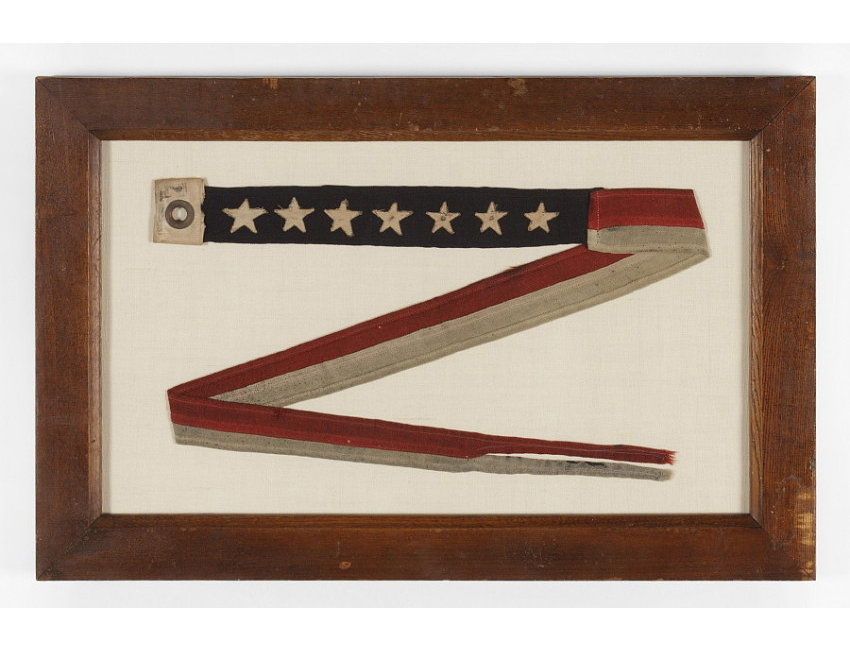|

|
Description: |
|
| 7 star nautical commissioning pennant, made during or shortly after WWII (U.S. involvement 1941-45). Commissioning pennants are the distinguishing mark of a commissioned U.S. Navy ship. A ship became commissioned when this pennant was hoisted. Flown during both times of peace and war, the only time the pennant is not flown is if a flag officer or civilian official is aboard and replaces it with their own flag.
This particular pennant belonged to USN Captain William Ross Banks (1923 - 1999) and was acquired from his son. Banks served on four different submarines before, during, and following WWII. Captain Banks, an Oklahoma City native and 1942 graduate of the U.S. Naval Academy, served 29 years in the Navy before retiring in 1971 and settling in Alexandria, Virginia. During World War II, he participated in patrols in the Pacific with the submarine USS Mingo. His service there earned him a Bronze Star.
His post-war submarine commands included the USS Cavalla and the USS Hawkbill. As part of an exchange program, he was squadron operations officer with the British Royal Navy from 1955 to 1957. He later served as commanding officer of the Naval Scientific and Technical Intelligence Center in Washington and commanding officer of the amphibious depot ship USS Cambria in Norfolk, an attack transport.
This pennant came from one of the above vessels. Some small text is stamped along the hoist. Although largely illegible, it appears to contain three words or abbreviations, one of which begins with two letter C's. The next may begin with a "B" and appears to contain 5 characters. It may read "CC Banks", though this is difficult to tell with certainty and the last word or abbreviation, which contains 3 characters, is unclear.
Based on its construction alone, I would expect a WWII or prior era ship, but it is difficult to put a hard date on the pennant. From a logistical standpoint, it seems likely that the signal came from one of the three boats that Banks commanded, but I have owned numerous pennants from WWII ships that were not taken home by the captain. If Banks was good friends with the signal officer, for example, or if he performed some heroic action, he might be gifted or awarded with a retired or perhaps even an unused flag or commissioning pennant. His bronze star during WWII would have been one such possibility. These signals didn't last long on the open seas, so regular replacement was necessary and ample stock of them was kept on active vessels.
Commissioning pennants were very important in their role as signals and thus needed to be seen from great distance. During the 18th and 19th centuries, they usually exceed ten feet in length, with some reaching as long as ninety feet. During the 1st quarter of the 20th they became largely ceremonial and customary. Most range between four feet (like this tiny example) and six feet in length. Today the largest commissioning pennants measure two-and-a-half inches by six feet.
Note that there are two sizes of stars, 4 larger and 3 smaller. Though the purpose is unknown, this arrangement is seen on many other commissioning pennants. It is interesting to note that according to the U.S. Navy, the reason for the choice of 7 stars was not recorded. I have always suspected that the number might reference the "7 Seas", though this is an ancient term and geographers disagree on the precise meaning. The number may just as likely have represented what seemed like a logical design choice when the overall length was substantially shortened.
This particular pennant is made of wool bunting with cotton stars that are appliqu�d with a zigzag, machine stitch. There is a canvas binding on the hoist with a single brass grommet. The number "7" is stenciled on the hoist to indicate size (meaning #7 as opposed to 7 feet).
Mounting: The solid oak molding dates to the period between 1900 and 1920 and retains its original varnished surface. The pennant has been hand-stitched to 100% hemp fabric. It has been folded back-and-forth in a visually interesting zigzag fashion, which simultaneously allows it to be accommodated in a frame of manageable size. Spacers keep the textile away from the glazing, which is U.V. protective glass. |
| Inventory Number: |
|
|
|
Dealer |
Jeff R. Bridgman American Antiques, llc |
| Contact |
Jeff |
Phone: (717) 502-1281 |
|
| Period: |
1st Half 20th Century (1901 -1949) |
|
| Date: |
1941-1859 |
|
| Origin: |
|
|
| Condition: |
There is expected wear and soling from use. |
|
| Measurements: |
Frame: 15.25" x 23.25" Flag: 2" x 16" (48" Unfurled) |
|
| Inventory |
Other Inventory by this Dealer |
|
| Web-site: |
http://www.jeffbridgman.com |
|
| Price: |
SOLD |
|
| E-mail: |
Inquire
|
|
Click thumbnail
to view larger
|
